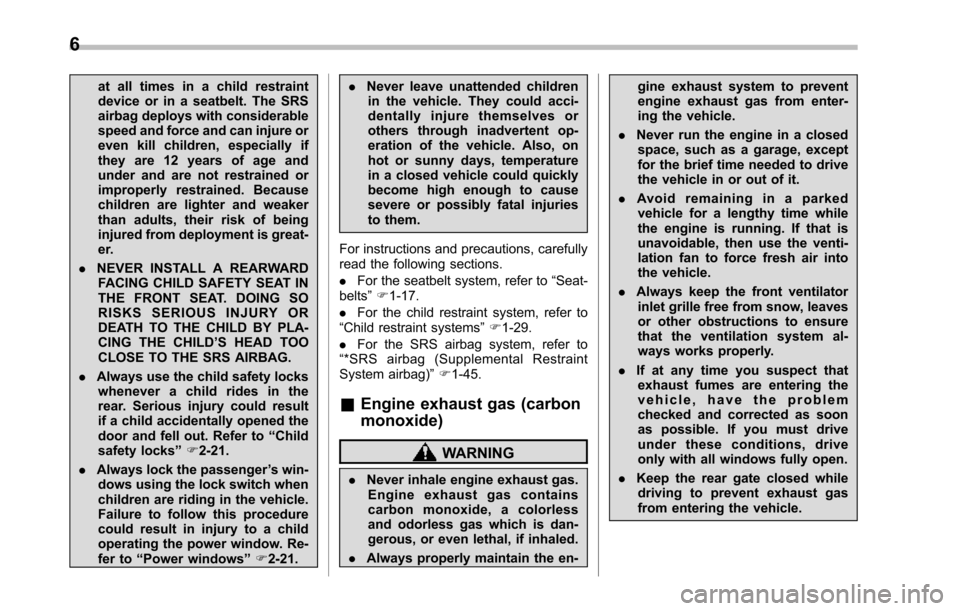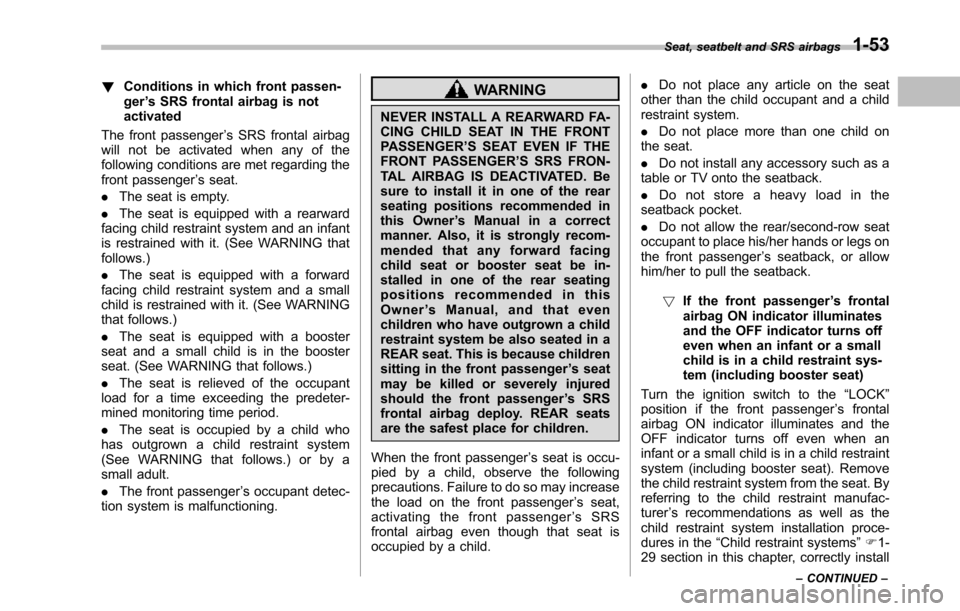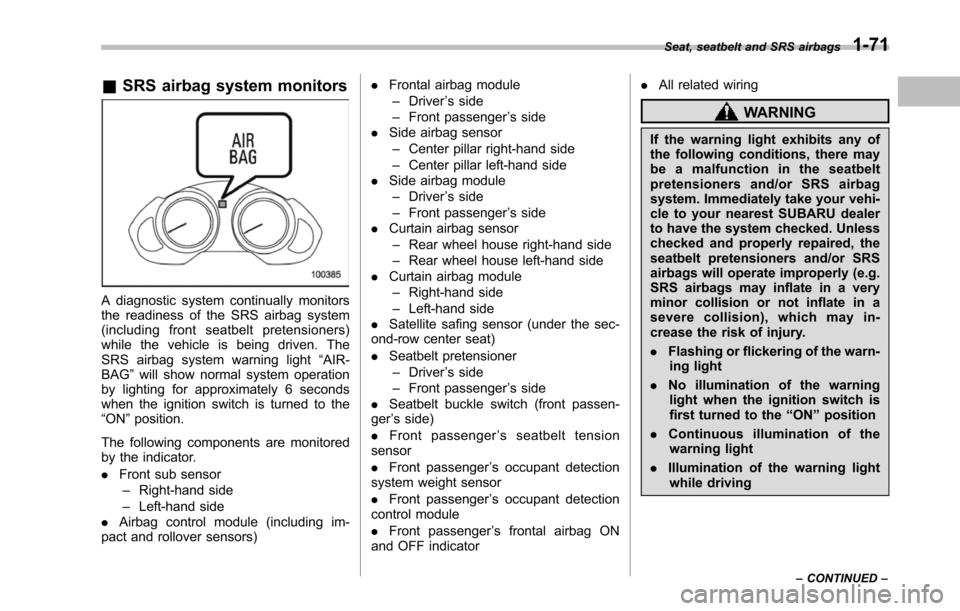2014 SUBARU TRIBECA air condition
[x] Cancel search: air conditionPage 2 of 426

Foreword
Congratulations on choosing a SUBARU vehicle. This Owner’sManual has all the information necessary to keep your SUBARU inexcellent condition and to properly maintain the emission controlsystem for minimizing emission pollutants. We urge you to readthis manual carefully so that you may understand your vehicle andits operation. For information not found in this Owner’s Manual,such as details concerning repairs or adjustments, please contactthe SUBARU dealer from whom you purchased your SUBARU orthe nearest SUBARU dealer.
The information, specifications and illustrations found in thismanual are those in effect at the time of printing. FUJI HEAVYINDUSTRIES LTD. reserves the right to change specifications anddesigns at any time without prior notice and without incurring anyobligation to make the same or similar changes on vehiclespreviously sold. This Owner’s Manual applies to all models andcovers all equipment, including factory installed options. Someexplanations, therefore may be for equipment not installed in yourvehicle.
Please leave this manual in the vehicle at the time of resale. Thenext owner will need the information found herein.
FUJI HEAVY INDUSTRIES LTD., TOKYO, JAPAN
is a registered trademark of FUJI HEAVY INDUSTRIES LTD.
*CCopyright 2012 FUJI HEAVY INDUSTRIES LTD.
Page 8 of 426

&Abbreviation list
You will find several abbreviations in thismanual. The meanings of the abbrevia-tions are shown in the following list.
Abbreviation Meaning
A/C Air conditioner
A/ELRAutomatic/Emergency lockingretractor
ABSAnti-lock brake system
AKI Anti knock index
ALR Automatic locking retractor
AT Automatic transmission
ATF Automatic transmission fluid
AWD All-wheel drive
DRL Daytime running light
EBDElectronicbrake force distri-bution
ELR Emergency locking retractor
GAW Gross axle weight
GAWR Gross axle weight rating
GVW Gross vehicle weight
GVWRGross vehicle weight rating
HID Highintensity discharge
INT Intermittent
LATCHLower anchors and tethers forchildren
Abbreviation Meaning
LED Light emitting diode
MIL Malfunction indicator light
MMTMethylcyclopentadienyl man-ganese tricarbonyl
OBD On-board diagnostics
RON Research octane number
SRSSupplemental restraint sys-tem
TIN Tire identification number
TPMSTire pressure monitoring sys-tem
VDCVehicle dynamics control
Vehicle symbols
There are some of the symbols you maysee on your vehicle.
For warning and indicator lights, refer to“Warning and indicator lights”F22.
Mark Name
WARNING
CAUTION
Passengers’windows lock
Fuel
Front fog lights
Parking lights
Hazard warning flasher
Seat heater
3
–CONTINUED–
Page 11 of 426

6
at all times in a child restraintdevice or in a seatbelt. The SRSairbag deploys with considerablespeed and force and can injure oreven kill children, especially ifthey are 12 years of age andunder and are not restrained orimproperly restrained. Becausechildren are lighter and weakerthan adults, their risk of beinginjured from deployment is great-er.
.NEVER INSTALL A REARWARDFACING CHILD SAFETY SEAT INTHE FRONT SEAT. DOING SORISKS SERIOUS INJURY ORDEATH TO THE CHILD BY PLA-CING THE CHILD’S HEAD TOOCLOSE TO THE SRS AIRBAG.
.Always use the child safety lockswhenever a child rides in therear. Serious injury could resultif a child accidentally opened thedoor and fell out. Refer to“Childsafety locks”F2-21.
.Always lock the passenger’s win-dows using the lock switch whenchildren are riding in the vehicle.Failure to follow this procedurecould result in injury to a childoperating the power window. Re-fer to“Power windows”F2-21.
.Never leave unattended childrenin the vehicle. They could acci-dentally injure themselves orothers through inadvertent op-eration of the vehicle. Also, onhot or sunny days, temperaturein a closed vehicle could quicklybecome high enough to causesevere or possibly fatal injuriesto them.
For instructions and precautions, carefullyread the following sections.
.For the seatbelt system, refer to“Seat-belts”F1-17.
.For the childrestraint system, refer to“Child restraint systems”F1-29.
.For the SRS airbag system, refer to“*SRS airbag (Supplemental RestraintSystem airbag)”F1-45.
&Engine exhaust gas (carbon
monoxide)
WARNING
.Never inhale engine exhaust gas.Engine exhaust gas containscarbon monoxide, a colorlessand odorless gas which is dan-gerous, or even lethal, if inhaled.
.Always properly maintain the en-
gine exhaust system to preventengine exhaust gas from enter-ing the vehicle.
.Never run the engine in a closedspace, such as a garage, exceptfor the brief time needed to drivethe vehicle in or out of it.
.Avoid remaining in a parkedvehicle for a lengthy time whilethe engine is running. If that isunavoidable, then use the venti-lation fan to force fresh air intothe vehicle.
.Always keep the front ventilatorinlet grille free from snow, leavesor other obstructions to ensurethat the ventilation system al-ways works properly.
.If at any time you suspect thatexhaust fumes are entering thevehicle, have the problemchecked and corrected as soonas possible. If you must driveunder these conditions, driveonly with all windows fully open.
.Keep the rear gate closed whiledriving to prevent exhaust gasfrom entering the vehicle.
Page 12 of 426

&Drinking and driving
WARNING
Drinking and then driving is verydangerous. Alcohol in the blood-stream delays your reaction andimpairs your perception, judgmentand attentiveness. If you drive afterdrinking - even if you drink just alittle - it will increase the risk ofbeing involved in a serious or fatalaccident, injuring or killing yourself,your passengers and others. Inaddition, if you are injured in theaccident, alcohol may increase theseverity of that injury.
Please don’t drink and drive.
Drunken driving is one of the mostfrequent causes of accidents. Since alco-hol affects all people differently, you mayhave consumed too much alcohol to drivesafely even if the level of alcohol in yourblood is below the legal limit. The safestthing you can do is never drink and drive.However if you have no choice but todrive, stop drinking and sober up comple-tely before getting behind the wheel.
&Drugs and driving
WARNING
There are some drugs (over thecounter and prescription) that candelay yourreaction time and impairyour perception, judgment and at-tentiveness. If you drive after takingthem, it may increase your, yourpassengers’and other persons’riskof being involved in a serious orfatal accident.
If you are taking any drugs, check withyour doctor or pharmacist or read theliterature that accompanies the medicationto determine if the drug you are taking canimpair your driving ability. Do not driveafter taking any medications that canmake you drowsy or otherwise affect yourability to safely operate a motor vehicle. Ifyou havea medical condition that requiresyou to take drugs, please consult withyour doctor.
Never drive if you are under the influenceof any illicit mind-altering drugs. For yourown health and well-being, we urge younot to take illegal drugs in the first placeand to seek treatment if you are addictedto those drugs.
&Driving when tired or sleepy
WARNING
When you are tired or sleepy, yourreaction will be delayed and yourperception, judgment and attentive-ness will be impaired. If you drivewhen tired or sleepy, your, yourpassengers’and other persons’chances of being involved in aserious accident may increase.
Please do not continue to drive butinstead find a safe place to rest if youare tired or sleepy. On long trips, youshould make periodic rest stops to refreshyourself before continuing on your journey.When possible, you should share thedriving with others.
7
–CONTINUED–
Page 84 of 426

!Conditions in which front passen-ger’s SRS frontal airbag is notactivated
The front passenger’s SRS frontal airbagwill not be activated when any of thefollowing conditions are met regarding thefront passenger’s seat.
.The seat is empty.
.The seat is equipped with a rearwardfacing child restraint system and an infantis restrained with it. (See WARNING thatfollows.)
.The seat is equipped with a forwardfacing child restraint system and a smallchild is restrained with it. (See WARNINGthat follows.)
.The seat is equipped with a boosterseat and a small child is in the boosterseat. (See WARNING that follows.)
.The seat is relieved of the occupantload for a time exceeding the predeter-mined monitoringtime period.
.The seat is occupied by a child whohas outgrown a child restraint system(See WARNING that follows.) or by asmall adult.
.The front passenger’s occupant detec-tion system is malfunctioning.
WARNING
NEVER INSTALL A REARWARD FA-CING CHILD SEAT IN THE FRONTPASSENGER’S SEAT EVEN IF THEFRONT PASSENGER’S SRS FRON-TAL AIRBAG IS DEACTIVATED. Besure to install it in one of the rearseating positions recommended inthis Owner’s Manual in a correctmanner. Also, it is strongly recom-mended that any forward facingchild seat or booster seat be in-stalled in one of the rear seatingpositions recommended in thisOwner’sManual,andthatevenchildren who have outgrown a childrestraint system be also seated in aREAR seat. This is because childrensitting in the front passenger’s seatmay be killed or severely injuredshould the front passenger’s SRSfrontal airbag deploy. REAR seatsare the safest place for children.
When the front passenger’s seat is occu-pied by a child, observe the followingprecautions. Failure to do so may increasethe load on the front passenger’s seat,activating the front passenger’sSRSfrontal airbag even though that seat isoccupied by a child.
.Do not place any article on the seatother than the child occupant and a childrestraint system.
.Do not place more than one child onthe seat.
.Do not install any accessory such as atable or TV onto the seatback.
.Do not store a heavy load in theseatback pocket.
.Do not allow the rear/second-row seatoccupant to place his/her hands or legs onthe front passenger’s seatback, or allowhim/her to pull the seatback.
!If the front passenger’s frontalairbag ON indicator illuminatesand the OFF indicator turns offeven when an infant or a smallchild is in a child restraint sys-tem (including booster seat)
Turn the ignition switch to the“LOCK”position if the front passenger’s frontalairbag ON indicator illuminates and theOFF indicator turns off even when aninfant or a small child is in a child restraintsystem (including booster seat). Removethe child restraint system from the seat. Byreferring to the child restraint manufac-turer’s recommendations as well as thechild restraint system installation proce-dures in the“Child restraint systems”F1-29 section in this chapter, correctly install
Seat, seatbelt and SRS airbags1-53
–CONTINUED–
Page 85 of 426

1-54Seat, seatbelt and SRS airbags
the child restraint system. Turn the ignitionswitch to the“ON”position and make surethat the front passenger’s frontal airbagON indicator turns off and the OFFindicator illuminates.
If the ON indicator still remains illuminatedwhile the OFF indicator turns off, take thefollowing actions.
.Ensure that no article is placed on theseat other than the child restraint systemand the child occupant.
.Ensure that there is no article left in theseatback pocket.
If the ON indicator still remains illuminatedwhile the OFF indicator turns off aftertaking relevant corrective actions de-scribed above, relocate the child restraintsystem to one of the rear seating positionsrecommended in this Owner’s Manual andimmediately contact your SUBARU dealerfor an inspection.
NOTE
When a child who has outgrown a childrestraint system or a small adult isseated in the front passenger’s seat,the SUBARU advanced frontal airbagsystem may or may not activate thefront passenger’s SRS frontal airbagdepending on the occupant’s seatingposture. If the front passenger’s SRS
frontal airbag is activated (the ONindicator remains illuminated whilethe OFF indicator turns off), take thefollowing actions.
.Ensure that no article is placed onthe seat other than the occupant..Ensure that there is no article left inthe seatback pocket.
If the ON indicator still remains illumi-nated while the OFF indicator turns offdespite the fact that the actions notedabove have been taken, seat the child/small adult in the rear seat and im-mediately contact your SUBARU dealerfor an inspection. Even if the systemhas passed the dealer inspection, it isrecommended that on subsequent tripsthe child/small adult always take therear seat.
Children who have outgrown a childrestraint system should always wear theseatbelt irrespective of whether the airbagis deactivated or activated.
!Conditions in which front passen-ger’s SRS frontal airbag is activated
The front passenger’s SRS frontal airbagwill be activated for deployment uponimpact when any of the following condi-tions is met regarding the front passen-ger’s seat.
.When the seat is occupied by an adult.
.When a heavy article is placed on theseat.
When the front passenger’s seat is occu-pied by an adult, observe the followingprecautions. Failure to do so may lessenthe load on the front passenger’s seat,deactivatingthe front passenger’s SRSfrontal airbag despite the fact that the seatis occupied by an adult.
.Do not allow the second-row seatoccupant to lift the front passenger’s seatcushion using his/her feet.
.Do not place any article under the frontpassenger’s seat, or squeeze any articlefrom behind and under the seat. This maylift the seat cushion.
.Do not squeeze any article betweenthe front passenger’s seat and side trim/pillar, door or center console box. Thismay lift the seat cushion.
!If the passenger’s frontal airbagOFF indicator illuminates andthe ON indicator turns off evenwhen the front passenger’s seatis occupied by an adult
This can be caused by the adult incor-rectly sitting in the front passenger’s seat.Turn the ignition switch to the“LOCK”position. Ask the front passenger to setthe seatback to the upright position, sit up
Page 87 of 426

1-56Seat, seatbelt and SRS airbags
!Operation
1) Driver’s side2) Passenger’s side
The SRS airbag can function only whenthe ignition switch is in the“ON”position.
The SUBARU advanced frontal airbag
system is designed to determine theactivation or deactivation condition of thefront passenger’sSRSfrontalairbagdepending on the total load on the frontpassenger’s seat monitored by the frontpassenger’s occupant detection systemweight sensor. For this reason, only thedriver’s SRS frontal airbag may deploy inthe event of a collision, but this does notmeanfailure of the system.
If the front sub sensors located on bothsides of the radiator panel and the impactsensors in the airbag control moduledetect a predetermined amount of forceduring a frontal collision, the controlmodule sends signals to the airbagmodule(s) (only driver’s module or bothdriver’s and front passenger’s modules)instructing the module(s) to inflate theSRS frontal airbag(s). The driver’s andfront passenger’s SRS frontal airbags usedual stage inflators. The two inflators ofeach airbag are triggered either sequen-tially or simultaneously, depending on theseverity of impact, backward-forward ad-justmentof the driver’s seat position andfastening/unfastening of the seatbelt in thecase of the driver’s SRS frontal airbag anddepending on the severity of impact andthe total load on the seat in the case of thefront passenger’s SRS frontal airbag.
After deployment, the SRS airbag imme-diately starts to deflate so that the driver’svision is not obstructed. The time requiredfrom detecting impact to the deflation ofthe SRS airbag after deployment is short-er than the blink of an eye.
When only the driver’s SRS frontal airbagdeploys and both the driver’s and frontpassenger’s SRS frontal airbags deploy,the driver’s and front passenger’s seatbeltpretensioners operate at the same time.
Although it is highly unlikely that the SRSairbag would activate in a non-accidentsituation, should it occur, the SRS airbagwill deflate quickly, not obscuring visionand will not interfere with the driver’sability to maintain control of the vehicle.
When the SRS airbag deploys, a sudden,fairly loud inflation noise will be heard andsome smoke will be released. Theseoccurrencesare a normal result of thedeployment. This smoke does not indicatea fire in the vehicle.
CAUTION
Do not touch the SRS airbag systemcomponents around the steeringwheel and dashboard with barehands right after deployment. Doingso can cause burns because the
Page 102 of 426

&SRS airbag system monitors
A diagnostic system continually monitorsthe readiness of the SRS airbag system(including front seatbelt pretensioners)while the vehicle is being driven. TheSRS airbag system warning light“AIR-BAG”will show normal system operationby lighting for approximately 6 secondswhen the ignition switch is turned to the“ON”position.
The following components are monitoredby the indicator.
.Front sub sensor–Right-hand side–Left-hand side.Airbag control module (including im-pact and rolloversensors)
.Frontal airbag module–Driver’s side–Front passenger’s side.Side airbag sensor–Center pillar right-hand side–Center pillar left-hand side.Side airbag module–Driver’s side–Front passenger’s side.Curtain airbag sensor–Rear wheel house right-hand side–Rear wheel house left-hand side.Curtain airbag module–Right-hand side–Left-hand side.Satellite safing sensor (under the sec-ond-row center seat)
.Seatbelt pretensioner–Driver’s side–Front passenger’s side.Seatbelt buckleswitch (front passen-ger’s side)
.Front passenger’sseatbelttensionsensor
.Front passenger’s occupant detectionsystem weight sensor
.Front passenger’s occupant detectioncontrolmodule
.Front passenger’s frontal airbag ONand OFF indicator
.All related wiring
WARNING
If the warning light exhibits any ofthe following conditions, there maybe a malfunction in the seatbeltpretensioners and/or SRS airbagsystem. Immediately take your vehi-cle to your nearest SUBARU dealerto have the system checked. Unlesschecked and properly repaired, theseatbelt pretensioners and/or SRSairbags will operate improperly (e.g.SRS airbags may inflate in a veryminor collision or not inflate in asevere collision), which may in-crease the risk of injury.
.Flashing or flickering of the warn-ing light
.No illumination of the warninglight when the ignition switch isfirst turned to the“ON”position
.Continuous illumination of thewarning light
.Illumination of the warning lightwhile driving
Seat, seatbelt and SRS airbags1-71
–CONTINUED–